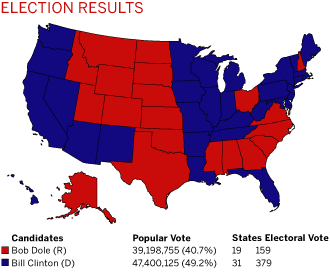Thanks to a robust economy and the absence of divisive foreign-policy issues in the presidential election, Bill Clinton enjoyed a relatively trouble-free ride on his way to becoming the first Democrat since Franklin Roosevelt to be elected to a second full term. Clinton’s victory represented an impressive political comeback. In 1994, Republicans had won control of both houses. Wielding enormous influence, House Speaker Newt Gingrich had forged the Republicans' "Contract with America," a conservative legislative agenda. During intense budget battles between the president and Congress, the federal government was shut down twice. Clinton blamed this on the Republicans, which enabled him to position himself in the center and portray the Republicans as extremists. The Clinton campaign repeatedly linked his opponent Bob Dole to Gingrich, while championing mainstream causes such as the Family Leave Act, college tuition credits, and a ratings system for television. Dole tried, without much success, to use the "character issue" to his advantage. Yet the public showed little interest in Clinton scandals such as "Whitewater," "Filegate," and "Travelgate," and allegations of campaign-finance abuse.
Democrat
Bill Clinton for president
Al Gore for vice president
"Building a Bridge to the 21st Century"
Bill Clinton’s ads consistently associated Bob Dole with House Speaker Newt Gingrich. Grainy black-and-white footage of Dole standing next to Gingrich exploited the public’s disenchantment with the Republican-led Congress following the shutdown of the federal government. In contrast with these ominous images, colorful, upbeat montages outlined Clinton’s achievements in a wide range of social programs. These ads took credit for the robust economy, and also played on the fear that the Republicans' assault on "big government" might threaten programs that the public supported, such as Social Security and education.
Other ads focused on micro-issues, such as Clinton’s support for school uniforms and a TV rating system. Using the phrase "protecting our values" as one of their slogans, the Clinton campaign was able to seize the political mainstream. Clinton’s support of the death penalty and intention to cut welfare were among the traditionally conservative positions heralded in his commercials. Above all, the consistency, high production values, and upbeat nature of the ads reflected competence while subtly raising questions about Dole’s advanced age.
Republican
Bob Dole for president
Jack Kemp for vice president
"A Better Man for a Better America"
Bob Dole’s commercials portray him as a war hero and a man of simple integrity, in contrast with Clinton’s questionable morals. However, polls repeatedly showed that, with the economy in good shape, the public was more interested in President Clinton’s job performance than in the numerous minor scandals that had emerged during his first term. Dole’s commercials, inconsistent in message and tone, failed to establish an effective target. One spot, "The Threat," began with footage from Lyndon Johnson’s famous 1964 "Daisy" commercial about the danger of nuclear war, and stated that the biggest threat was drugs. But the ad never made clear how this problem was linked to Clinton. Dole’s proposal of a 15 percent tax cut was cited in numerous ads, yet without any explanation of how it would have been funded. With a healthy economy, and a shrinking budget deficit, a tax cut was not a high priority for voters.
